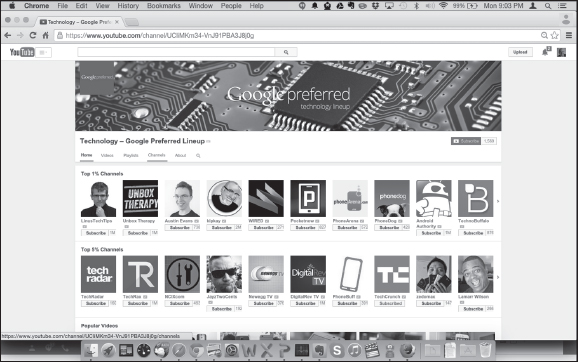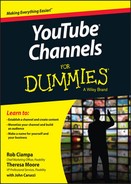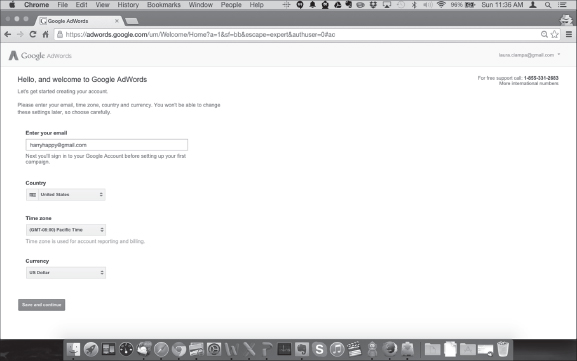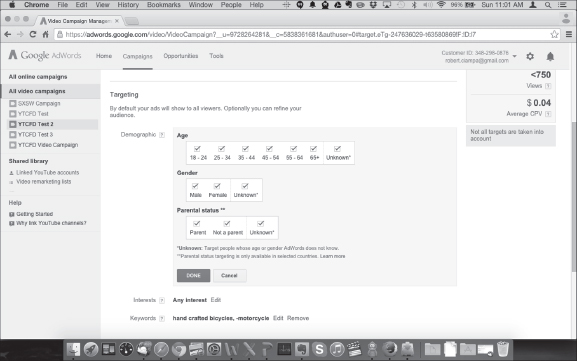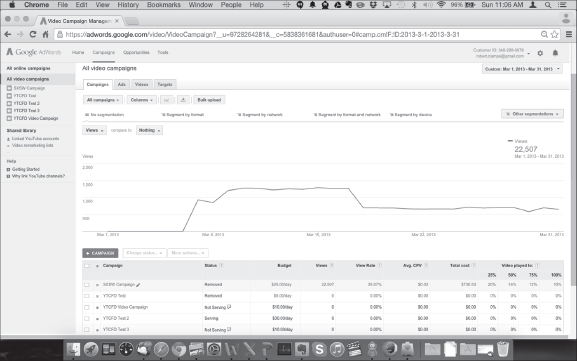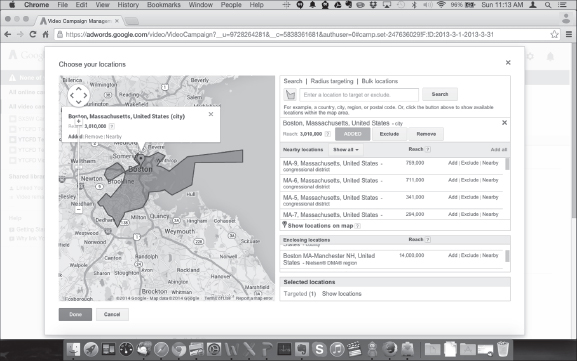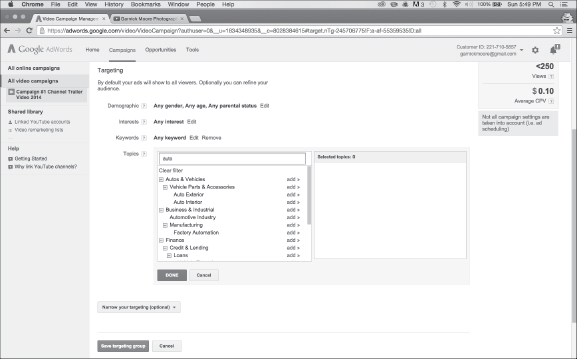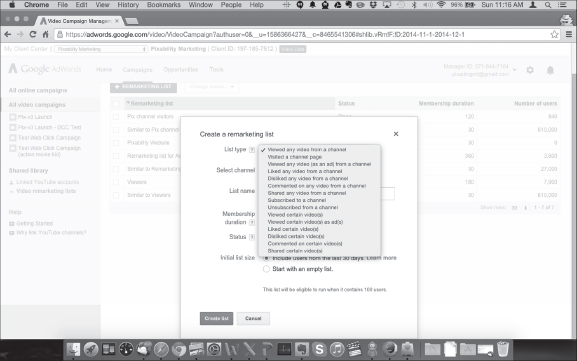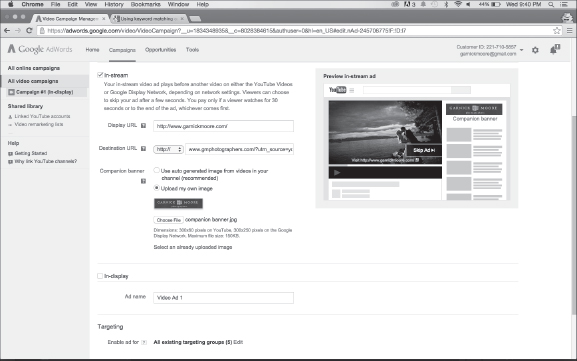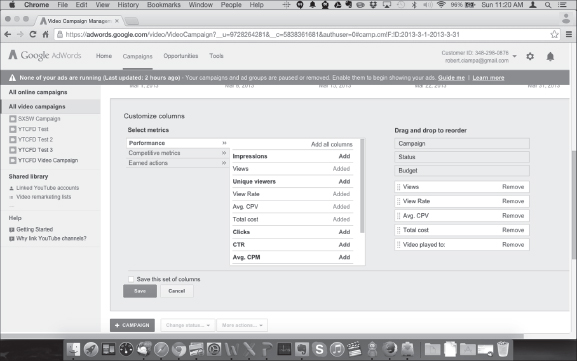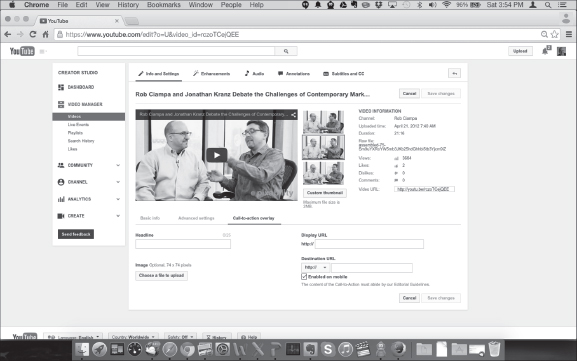Chapter 13
Expanding Your Audience through YouTube Advertising
In This Chapter
- Using advertising to reach a broader audience on YouTube
- Setting up and running a YouTube ad campaign
- Picking the right type of ad campaign
- Understanding the importance of earned metrics
- Adjusting ad campaigns to increase performance and clicks
Many channel managers often believe that after their channels are set up, their view counts are increasing, their subscriptions are growing, and engagement is up, they can then sit back and focus on making some content. Well, that's not exactly the case. You have another powerful resource in your tool chest that can potentially take your channel to the next level: It's advertising.
Now, before you close this book with a sigh, sure as sure can be that advertising is nothing more than a fancy way of throwing away money and annoying people, you'd better think again. YouTube advertising is highly effective because it allows you to reach a large part of your target audience who may not have discovered your channel and your content organically — without the help of advertising, in other words.
Unlike many types of advertising, well-run YouTube ad campaigns end up delivering not only views but also increased watch time and additional subscriber growth, both of which are great for your channel in YouTube's eyes. Why? Because effective YouTube advertising can help with discoverability, creating a virtuous cycle for your channel. A well-targeted ad campaign lets the right kind of viewers discover your channel — those you really want to reach. Once they subscribe and watch other videos on your channel after seeing your ads, your channel's search ranking will improve, which in turn will let other viewers with similar interests discover your content.
YouTube advertising builds on Google's successful AdWords product — one of the world's most popular advertising platforms. The part that ties into YouTube is AdWords for Video. As you can probably imagine, many ad types can be used with YouTube. Chances are good that you've seen the video masthead ad on YouTube's home page or animated ad overlays over the lower center area of YouTube videos. This chapter focuses on the specific ad types you configure via AdWords for Video. They're called YouTube TrueView ads.
YouTube TrueView ads are different from many other types of ads because you as the advertiser pay only if the viewer does something concrete, such as watch a video ad or click on a display ad. TrueView ads include both video and display ad formats. In other words, some ads use videos, and others use regular display ads, with just a static image and some text. A pre-roll ad is a video ad that is shown immediately before displaying the video that the viewer clicked to see. If you've been on YouTube, you've seen them. They're the ones that let you skip off after 5 seconds. Concerned that tons of people are sure to skip off after the first 5 seconds? Don't be. The good part is that you pay only for the viewers who choose to watch rather than those who skip off. In other words, you pay only for viewers who have a strong interest in the ad you've put in front of them.
 Most channel managers should have no problem setting up an ad campaign for YouTube. Though you have to complete quite a few steps to set up an ad, most of the time you can simply use the default values for each step. Over time, you tweak the settings to produce even better results, but for your first campaign, we recommend sticking with the defaults.
Most channel managers should have no problem setting up an ad campaign for YouTube. Though you have to complete quite a few steps to set up an ad, most of the time you can simply use the default values for each step. Over time, you tweak the settings to produce even better results, but for your first campaign, we recommend sticking with the defaults.
Google Display Network
You're not restricted to YouTube for your TrueView ads. Google also has the Google Display Network (GDN), a massive, worldwide collection of more than 2 million websites that allow display and video advertising. Ads on the GDN can support all screen types, including desktop computers, laptops, tablets, and smartphones. A majority of the world's most heavily trafficked websites are part of the GDN, but that doesn't ensure that you'll be able to run placements on only the best sites.
You have the option during the YouTube ad campaign setup to include the GDN for placement of your ads. When setting up targeting groups for your ads, you can also itemize specific placement within YouTube and within the GDN. The GDN supports all types TrueView ads.
Understanding YouTube Advertising
To understand YouTube advertising, you need to know a little bit about Google advertising. You may believe that Google is simply a big search engine company, but it's really a big advertising company — that's where it makes its money. The same logic holds true for YouTube. People think of it as an amazing video site, but at its core, it's really a major advertising platform.
A fortune is being spent and made on YouTube. You know all those YouTube stars like PewDiePie, Jenna Marbles, and Ray William Johnson? They're earning the lion's share of their money from advertising. Granted, they're also now signing other types of lucrative endorsement deals, but their YouTube fame led to their first fortune — and that came from advertising.
 There are two sides to the advertising equation:
There are two sides to the advertising equation:
- Advertiser: The person or organization paying for and placing the ads
- Publisher: The person or organization whose property has the ad placed on it and who receives a cut of revenue from the ad
On YouTube, you can be an advertiser or a publisher, or both. In this chapter, you can read about the advertiser side. Chapter 14 tells you all about the publisher side.
Other YouTube ad formats and pricing models
TrueView in-stream and in-display aren't the only ad types available on YouTube, but they're highly effective for many advertisers because they are charged only when a viewer watches the whole ad or — for longer ads — at least the first 30 seconds. There are other types of ads, however, such as a masthead (the big ad that shows up on the YouTube home page) or an in-video overlay (an ad that appears in the lower center of a video and acts like an annotation). For more on these (and other) ad types, go to www.youtube.com/yt/advertise/.
You may also want to check out Google AdWords For Dummies, by Howie Jacobson, Joel McDonald, and Kristie McDonald (John Wiley & Sons, Inc.). It provides all the details you need to become an AdWords guru.
TrueView ads' claim to fame is that they use cost per view (CPV) pricing. Other ad types may have different pricing methods, including cost per thousand impressions, also known as CPM. As you advertise more, it's worth your time to explore all ad types available via Google for YouTube.
 Google and YouTube help on both sides of the advertising equation and have product offerings for both. On the advertiser side, you use Google AdWords for Video, which we cover later in this chapter. On the publisher side, you use Google AdSense to manage how your YouTube channel receives ads. (For more on Google AdSense in a YouTube context, check out Chapter 14.) Don't assume that you have to connect with publishers directly. Google acts as an intermediary — for a share of your profits, of course. (It's more proof that nothing in this life is ever free.)
Google and YouTube help on both sides of the advertising equation and have product offerings for both. On the advertiser side, you use Google AdWords for Video, which we cover later in this chapter. On the publisher side, you use Google AdSense to manage how your YouTube channel receives ads. (For more on Google AdSense in a YouTube context, check out Chapter 14.) Don't assume that you have to connect with publishers directly. Google acts as an intermediary — for a share of your profits, of course. (It's more proof that nothing in this life is ever free.)
Recognizing the importance of ad policy
If you're new to YouTube advertising, take a few minutes to understand ad policy, which basically states that advertising should conform to certain behavioral standards. (Go to http://support.google.com/adwordspolicy for details.) Better yet, check out Chapter 9, which talks in some detail about the YouTube community guidelines — rules for everything from obscene material to copyright infringement and privacy controls. Google does its utmost to ensure that appropriate and relevant ads are placed, but both advertisers and publishers have further control as well.
 Community guidelines are upheld nonstop, all day and all year. Violations not only jeopardize your ability to advertise, but you also risk your channel being taken down.
Community guidelines are upheld nonstop, all day and all year. Violations not only jeopardize your ability to advertise, but you also risk your channel being taken down.
In addition to being in line with the YouTube community guidelines, ads must conform to technical guidelines and specification. This helps ensure both consistency and fairness across the YouTube platform; it also lowers the likelihood that you'll annoy viewers. Ad format details can be found at http://support.google.com/displayspecs.
Looking at YouTube ad types
This chapter concentrates on YouTube TrueView ads. These formats work well for many advertisers because charges occur only when a viewer watches an ad or clicks on a video thumbnail. This is a signal of a higher degree of audience interest, making those viewers much better targets for your ads.
YouTube TrueView ads come in two flavors: in-stream ads and in-display ads. In-stream ads work a bit like TV commercials. Before users can see the video they want to watch, they have to watch your video ad first. This is known as a pre-roll ad. YouTube lets users skip an in-stream ad after 5 seconds, but they can also click on the call to action banner to go directly to your website or YouTube channel.
As for the in-display ads, they appear on search results pages and on YouTube Watch pages and are marked with a gold AD icon. (Figure 13-1 shows a typical example of an in-display ad above the organic search results.)
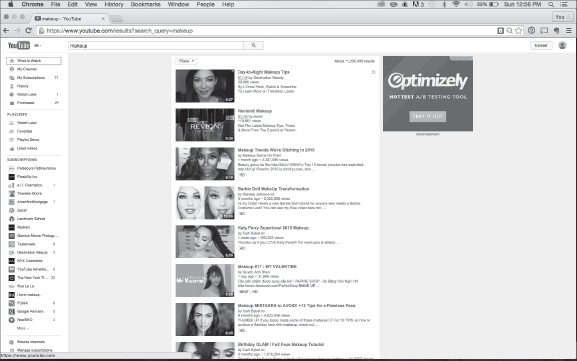
Figure 13-1: YouTube in-display ads appear on top of search-results pages.
 Since YouTube prioritizes videos with longer viewer session watch times and high engagement rates in its search results, highly engaged viewers from paid ads can support your SEO efforts.
Since YouTube prioritizes videos with longer viewer session watch times and high engagement rates in its search results, highly engaged viewers from paid ads can support your SEO efforts.
 You can go to http://support.google.com/youtube to learn all about the other ad types. Remember that YouTube TrueView ads are a great way to start your advertising work. To learn more about all the YouTube ad types, check out the YouTube media guidebook from Pixability, a company that specializes in YouTube marketing and advertising: www.pixability.com/industry-studies/mediaguidebook/.
You can go to http://support.google.com/youtube to learn all about the other ad types. Remember that YouTube TrueView ads are a great way to start your advertising work. To learn more about all the YouTube ad types, check out the YouTube media guidebook from Pixability, a company that specializes in YouTube marketing and advertising: www.pixability.com/industry-studies/mediaguidebook/.
Planning for Advertising
Advertising on YouTube requires some familiarity with Google AdWords. (Luckily for you, you can achieve the necessary level of familiarity simply by reading this chapter.) First and foremost, you need a Google AdWords account, which you can easily access via your regular Google account.
Note, however, that you need to explicitly tie your AdWords account to your YouTube account. (Don't worry: We show you how to do that as well.)
 You don't need to learn all about AdWords to work your YouTube advertising magic. However, if you have a commerce website and need to drive more traffic, you may want to consider learning a lot more. In that case, we recommend Google AdWords For Dummies, by Howie Jacobson, Joel McDonald, and Kristie McDonald (John Wiley and Sons, Inc.).
You don't need to learn all about AdWords to work your YouTube advertising magic. However, if you have a commerce website and need to drive more traffic, you may want to consider learning a lot more. In that case, we recommend Google AdWords For Dummies, by Howie Jacobson, Joel McDonald, and Kristie McDonald (John Wiley and Sons, Inc.).
Creating an AdWords account
Creating an AdWords account used to be pretty involved, but that was then. Fortunately, Google has greatly simplified the process of opening a new AdWords account:
- Point your web browser to http://adwords.google.com/video.
- (Optional) Choose a language other than English (US) from the drop-down on the bottom right.
Google translates the page into that language.
- Log in with your Google account.
Normally you'd use the same Google account you'd use to manage your YouTube channel.
 If you already have a Google account for Gmail, YouTube, or another Google service, you can use it for your AdWords account. If you're a Gmail junkie, for example, connect the accounts so that you don't sign yourself out of AdWords every time you check your mail. If you already have a Google Analytics account (a free service that measures what visitors do on your website), the email address of your AdWords account must be the same as your Analytics admin user email.
If you already have a Google account for Gmail, YouTube, or another Google service, you can use it for your AdWords account. If you're a Gmail junkie, for example, connect the accounts so that you don't sign yourself out of AdWords every time you check your mail. If you already have a Google Analytics account (a free service that measures what visitors do on your website), the email address of your AdWords account must be the same as your Analytics admin user email. - Click the Skip the Guided Setup link.
This setup process is designed for search advertising, not video ads, so you don't need to go through it.
- In the new screen that appears, select your time zone and currency from the drop-down lists and then click the Save and Continue button. (See Figure 13-2.)
 Google might change the sign-up process and its billing practices at any time, so take the preceding instructions with a grain of salt. They may be accurate for years — or they may be out of date one week after this book shows up in the bookstore.
Google might change the sign-up process and its billing practices at any time, so take the preceding instructions with a grain of salt. They may be accurate for years — or they may be out of date one week after this book shows up in the bookstore.
Figure 13-2: Setting up an AdWords for Video account.
Linking your AdWords account and YouTube channel
For your YouTube advertising project, you should link your AdWords account with your YouTube channel to access deeper ad analytics. A wellrun YouTube ad campaign produces lots of views, subscriptions, engagements, and clicks. By linking your accounts, you have access to much deeper statistics.
To link your accounts, follow these steps:
- Log in to your AdWords account.
- Copy your customer ID.
An AdWords customer ID is a three-part number that uniquely identifies your AdWords account. You'll find it in the top right corner of your AdWords page, right above your email address and to the left of the account settings icon.
- Log on to your YouTube account.
- On your YouTube page, click your channel's icon and then choose Creator Studio from the menu that appears.
Doing so brings up the Creator Studio dashboard.
- In the Navigation menu on the left, click the Channel section of Creator Studio.
The Channel section expands to show its subsections.
- Click the (newly revealed) Advanced heading in the Channel section.
- Click the Link an AdWords account button.
Doing so brings up the Link an AdWords for Video Account dialog box, as shown in Figure 13-3.
- Paste the customer ID that you copied in Step 2 into the dialog box's Customer ID text field.
- Click the Next button.
A new dialog box with all the linkage details appears, as shown in Figure 13-4.
- Enter a descriptive name of the AdWords account you're linking into the Assign a Name to the AdWords Account text field.
- Select the account permissions.
Linking your AdWords and YouTube accounts gives you access to additional capabilities. These include
- View counts and call-to-action, which will provide you with more detailed information about video views and will let you add a clickable call-to-action button to your video ads.
- Remarket, which will enable you to show your ad to viewers who previously visited your channel.
- Engagement, which shows you what viewers do after seeing your ad
 We recommend checking all options as part of your initial campaigns.
We recommend checking all options as part of your initial campaigns. - Click Finish.
Your AdWords account is now linked with your YouTube channel, and your permissions settings are saved.
 You can unlink the AdWords account that you associated with your YouTube channel at any point, if you feel so inclined. Just remember that, by unlinking your accounts, you lose access to earned metrics, which measure the impact your advertising has had on important channel metrics such as views and subscriptions. You can find out more about earned metrics later in this chapter.
You can unlink the AdWords account that you associated with your YouTube channel at any point, if you feel so inclined. Just remember that, by unlinking your accounts, you lose access to earned metrics, which measure the impact your advertising has had on important channel metrics such as views and subscriptions. You can find out more about earned metrics later in this chapter.
Figure 13-3: Moving your AdWords customer ID into YouTube.
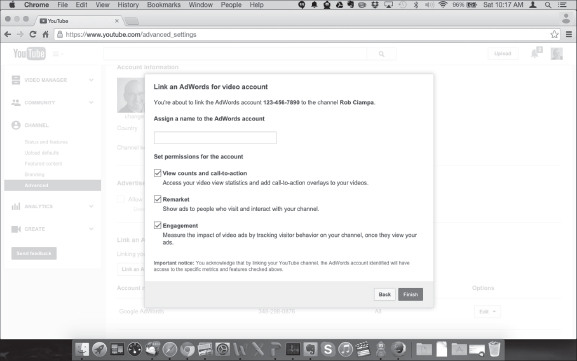
Figure 13-4: Linking your AdWords account and YouTube channel.
Determining Your Ad Targets
Before starting your campaign, you have to determine where you want your ads placed. This is known as ad targeting. AdWords for Video provides extremely rich and powerful targeting options. Each set of options is known as a targeting group, and you can use multiple, simultaneous targeting groups in the same campaign.
 Running a YouTube ad campaign isn't like placing an ad in a magazine or a commercial on television, where the ad is placed and you're done. Effective digital marketing — marketing that relies on YouTube and on display and search advertising — allows advertisers to constantly “tune” ad performance by making adjustments throughout the campaign, which may include changing the targets.
Running a YouTube ad campaign isn't like placing an ad in a magazine or a commercial on television, where the ad is placed and you're done. Effective digital marketing — marketing that relies on YouTube and on display and search advertising — allows advertisers to constantly “tune” ad performance by making adjustments throughout the campaign, which may include changing the targets.
 You can set up multiple targeting groups throughout a campaign, so don't try to be exhaustive out of the chute. You can even share or update target groups among campaigns, which allows you to streamline your campaign setup and management.
You can set up multiple targeting groups throughout a campaign, so don't try to be exhaustive out of the chute. You can even share or update target groups among campaigns, which allows you to streamline your campaign setup and management.
Setting up general targeting
To get started with YouTube TrueView advertising, you need to get a handle on the basics of ad targeting. Your default AdWords for Video setup lets you target using the following criteria:
- Demographics: This option lets you select your audience characteristics by age, gender, and parental status, as shown in Figure 13-5. Always choose the age and gender of your targeting audience, if you know it.
YouTube does not let you target viewers under the age 18. You can, however, make some assumptions that parents with young children will share devices (and, by default, Google accounts) with their kids. (Parental status targeting isn't available in all countries.)
- Interests: This option lets you identify specific viewer characteristics that you want targeted. Interest groups allow you to target viewers who are interested in that topic even when they are not viewing content about that topic. Google determines viewers' interests by analyzing the type of videos they're watching and by the websites they're visiting.
- Keywords: This option lets you target videos that are relevant to the keywords you itemize. For example, if you have a video ad for your pottery product, pottery would then be a good keyword to add to your campaign.
Figure 13-5: Your AdWords for Video demographic targeting options.
 Start off with broad keywords, you can always add in more niche terms after testing. Keywords are used to deliver ads for both YouTube search and watch, along with the Google Display Network.
Start off with broad keywords, you can always add in more niche terms after testing. Keywords are used to deliver ads for both YouTube search and watch, along with the Google Display Network.
 Adding a minus sign (−) in front a keyword ensures that your ad won't show against content that matches this keyword. If you don't want your audience to be reminded of the fact that pottery might break, you might enter −glue as a keyword to filter out any videos dealing with glue.
Adding a minus sign (−) in front a keyword ensures that your ad won't show against content that matches this keyword. If you don't want your audience to be reminded of the fact that pottery might break, you might enter −glue as a keyword to filter out any videos dealing with glue.
 We're giving you the lay of the land right now when it comes to preparing for your YouTube ad campaign. As for the nuts and bolts of setting up a YouTube ad campaign, we cover that topic a bit later in this chapter (in the section that just happens to be entitled “Setting Up a YouTube Ad Campaign”).
We're giving you the lay of the land right now when it comes to preparing for your YouTube ad campaign. As for the nuts and bolts of setting up a YouTube ad campaign, we cover that topic a bit later in this chapter (in the section that just happens to be entitled “Setting Up a YouTube Ad Campaign”).
Configuring more narrow targeting
Even though general targeting may work for your campaign, you'll probably get better results by using more narrow targeting. AdWords for Video lets you get more detailed and select your targets by letting you focus on the following categories.
- Topics: You can target specific content on either YouTube or the GDN corresponding to the selected topic. When configuring topic-based targeting, you can go broadly, such as Home & Garden, or be more specific in the category by selecting Rugs & Carpets under the Home Furnishings subcategory. (Note that you can select different topics in the same group.)
 Topic-based targeting applies only to video content on YouTube and the GDN, not to display ads.
Topic-based targeting applies only to video content on YouTube and the GDN, not to display ads. - Remarketing: You can target viewers who have interacted with your channel, videos, or website. That means they have done one of the following:
- Viewed your content
- Looked at your ads
- Engaged with your videos
- Visited your channel
- Subscribed (or unsubscribed) from your channel
By linking your AdWords for Video and YouTube accounts, you can remarket to these viewers or visitors. You target with remarketing by creating a remarketing list, which you can find out about in the next section. You can use several different remarketing lists in the same advertising campaign.
 Remarketing is just a fancy term for targeting users who have already interacted with you. Google and YouTube privacy rules prevent you from knowing who they specifically are, but that shouldn't prevent you from giving those remarketed viewers a more customized ad experience. For example, if viewers have watched a particular video, you can serve them a different video ad next, rather than the same one.
Remarketing is just a fancy term for targeting users who have already interacted with you. Google and YouTube privacy rules prevent you from knowing who they specifically are, but that shouldn't prevent you from giving those remarketed viewers a more customized ad experience. For example, if viewers have watched a particular video, you can serve them a different video ad next, rather than the same one.You can also remarket to viewers who have watched videos similar to the ones on your channel. This strategy significantly increases the reach of your ads.
 AdWords for Video treats remarketing lists and interest groups together, so have an interest group set up if you're using remarketing.
AdWords for Video treats remarketing lists and interest groups together, so have an interest group set up if you're using remarketing. - Placements: You can create a list of YouTube channels, specific videos, exact websites, or itemized pages in the GDN where you want your ad served. This is an excellent way to ensure that your content is appearing in the right places next to videos about specific topics. (Placements apply only to YouTube videos and to the GDN, not to YouTube Search.)
To access your more advanced targeting options, click on the Narrow Your Targeting (Optional) drop-down menu, as shown in Figure 13-6.
Figure 13-6: Your AdWords for Video targeting options.
Navigating the AdWords for Video Page
AdWords for Video has a powerful interface that lets you set up and check the status of your campaigns. Using this single interface, you can look at the performance of all your campaigns (see Figure 13-7) or dive into a particular campaign.
Exploring the Campaign navigation menu
The Campaign navigation menu appears on the left side of the page (refer to Figure 13-7) and consists of these sections:
- All online campaigns: This one shows all your AdWords campaigns, including display campaigns.
- All video campaigns: This option limits the view to just your AdWords for Video campaigns. By default, you see all your video campaigns. If you want the details about a specific campaign, simply click on the campaign name.
- Shared libraries: Here you'll find a list of YouTube accounts and video remarketing lists. If you haven't linked your AdWords account with your YouTube account yet, you can start that process by selecting the Linked YouTube Accounts option. If your campaigns will include remarketing, you can set that up by clicking the Video Remarketing Lists option.
- Help: This option offers additional help for AdWords for video.
Figure 13-7: The Campaigns tab for all video campaigns in an AdWords account.
 If you're familiar with the YouTube Analytics interface, you may see some similarities. For example, you can filter your results using the date pull-down in the top right corner, just as you would with YouTube Analytics.
If you're familiar with the YouTube Analytics interface, you may see some similarities. For example, you can filter your results using the date pull-down in the top right corner, just as you would with YouTube Analytics.
Looking at your campaign details
If you've clicked on All Video Campaigns or on a specific campaign, you see some (or all) of the following tabs appear in the Details section in the main pane of the interface window:
- Campaigns: This tab shows up only when you choose All Video Campaigns. You use this tab to set up a campaign.
- Ads: This tab displays your actual ads. You can have multiple ads running in a campaign.
- Videos: This tab lists the videos that are used as your ads.
- Targets: This tab lists your targeting groups.
- Settings: This tab shows up only when you click a specific campaign; it details such areas as budget and scheduling.
 If you have many more tabs showing than what we list here, you've likely clicked All Online Campaigns. Simply click All Video Campaigns in the Navigation menu on the left side to get to the right place.
If you have many more tabs showing than what we list here, you've likely clicked All Online Campaigns. Simply click All Video Campaigns in the Navigation menu on the left side to get to the right place.
Other important parts of the AdWords for Video interface include information around reporting, metrics, and ad performance. Key areas include
- Details buttons: These are found under the main tabs and allow you to
- View specific campaign, ad, and targeting information
- Control chart visibility
- Upload campaign configuration data (for power users who enjoy using spreadsheets)
- Download campaign reporting metrics to a spreadsheet
Depending on which tabs or Details button you select, you may (or may not) see the following interface details.
- Chart: After you've determined what to analyze, you can get lots of information with some fairly flexible graphical representations of your campaign performance — your views, for example, cost per views, impressions, and more. (An Analytics Chart section is shown in Figure 13-8.)
- Details section: This section appears when you scroll down on the page. It shows itemized details that correspond to the campaign details, such as lists of campaigns that are running or stopped, ads, videos, and target groups.
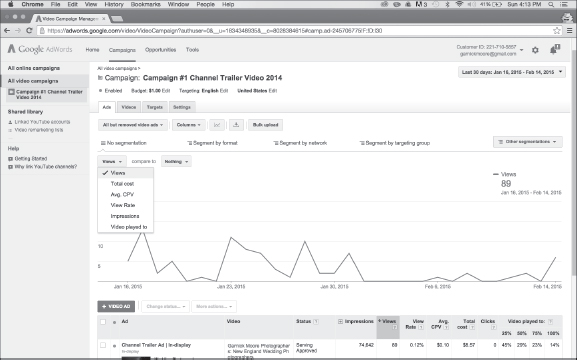
Figure 13-8: AdWords for Video campaign analytics.
Setting Up a YouTube Ad Campaign
So you've informed yourself about the costs and benefits of YouTube advertising and decided to give it a shot. We can only say, “Smart move.” Now it's time to get your hands dirty and set up your first YouTube ad campaign.
Going with a general campaign
Unfortunately, no one has yet invented a robot that sets up YouTube video ads for you. The process might sound a bit complicated at first because AdWords for Video is quite powerful, but it's fairly easy to start your first campaign. To set up a new YouTube ad, follow these steps:
- Log in to https://adwords.google.com/video.
If you haven't created an AdWords account yet, do so by following the instructions in the “Creating an AdWords account” section, earlier in this chapter.
- Click the + Campaign button at the top of the Details section.
A Create New Video Campaign page appears onscreen.
- (Optional) Click the Load Settings button if you have an earlier campaign and you want to reuse some of its configuration data.
As you become more proficient in running campaigns, you can save time and automatically populate new campaign fields by reusing older content. You can also change the settings for the campaign even after you've autoloaded it.
- Enter a name for your campaign in the Campaign Name field.
Choose a relevant and informative name such as Acme Electric Z500 Product Launch as opposed to Campaign #1. If you have special targeting, add words such as mobile or desktop to the campaign name. This will make it easier to identify and manage these particular campaigns later in the list of all your campaigns.
 Don't rush through the naming process; you want to be as descriptive as possible. Trust us: You're sure to forget important campaign details even if you have only a few campaigns.
Don't rush through the naming process; you want to be as descriptive as possible. Trust us: You're sure to forget important campaign details even if you have only a few campaigns. - Enter your daily budget in the Budget field.
This is the amount you're willing to spend per day on your ads. You can increase or decrease the budget at any time, so enter an amount that you feel comfortable to experiment with. Start with a small amount, such as $50, and increase it gradually as you start seeing the results you want.
- Pick your ad delivery method.
You set the rate at which your ads are served over the course of a day. Click Standard if you want them spread evenly over your ad day. Select Accelerated to deliver your ads rapidly.
 Your ad budget is daily. If you run an accelerated campaign and max out your daily budget, your ads stop for the day and start up again during the next day you're serving ads.
Your ad budget is daily. If you run an accelerated campaign and max out your daily budget, your ads stop for the day and start up again during the next day you're serving ads. - Select your networks.
These are the types of places where your ads will appear.
As a YouTube advertiser, you have three choices for where your ads are shown:
- YouTube Search: You get to post your TrueView ads in search queries. The only allowed ad type is TrueView in-display.
- YouTube Videos: You run either in-stream video ads against YouTube videos or in-display ads on the YouTube Watch page.
- Google Display Network: You have to also select the YouTube Video network option above. The GDN supports both in-stream and in-display ad formats.
- Pick your locations.
Don't let the simple interface fool you. You have the option to pick worldwide, United States, or Canada, but when you click Let Me Choose, you're presented with a powerful interface that lets you do precision location targeting of your ads, down to the city or area level. (To see how specific geo location targeting can get, check out Figure 13-9.) You can mix and match locations, but you also have the option to exclude certain areas.
 You can not only run ads on a specific region but also put together simultaneous campaigns with region-specific offers.
You can not only run ads on a specific region but also put together simultaneous campaigns with region-specific offers. - Choose the language of the viewers who will see your ads.
This step ensures that your ad appears only in places where the language of the ad matches the language of the targeted audience — an important consideration when you're dealing with GDN targeting.
- (Optional) Enter the video ad you want to use.
If you already know which of your existing videos you want to use for your campaign, select it here. The easiest way is to copy the URL of your video (https://www.youtube.com/watch?v=0XiC830EhHQ, for example) and paste it into this field.
Any video that you want to use for your ad campaign has to be previously uploaded to your YouTube channel. If you haven't done this yet or if you want to decide later which video to use, you can leave this field empty for now.
Figure 13-9: Precision targeting for YouTube TrueView ads.
 You can always enter a video later or add more than one video to an existing campaign. See the “Placing and Managing Your Ads” section, later in this chapter, for all the details on ad configuration.
You can always enter a video later or add more than one video to an existing campaign. See the “Placing and Managing Your Ads” section, later in this chapter, for all the details on ad configuration. - Select the platform and carrier on which the ad can appear.
Your target audience may prefer one platform or carrier over another. AdWords for Video therefore lets you specify desktops, smartphones, or tablets as targets and choose to place ads only on specific mobile providers by country, such as AT&T, Verizon, or others in the United States.
- Configure mobile bid adjustments.
Always strive to get the best mix of ads for your ad campaign. If you discover that mobile ads are your least successful ad type, you can use mobile bid adjustments to change the ratio of mobile ads all the way down to 0 percent so that none of your ads shows on mobile. (Just set your mobile bid adjustment to −100 percent.) If mobile ads end up being quite successful, you may want to adjust the bid +20 percent; this number allows your maximum bid to raise by 20 percent for mobile.
- Schedule when your ad runs.
You get to pick when your ad campaign starts and ends, along with the days and times you want it to run. You can leave this option empty and manually start and end campaigns as needed.
 Ad scheduling is helpful if you know when your viewers are watching and would likely see your ads. For example, if you're in the beauty or fashion business and you want to target women getting ready for work, you'd likely schedule your ads for weekday mornings. This strategy is especially helpful if you accelerate your ads; you don't want to burn up all your budget before your core target audience is even awake.
Ad scheduling is helpful if you know when your viewers are watching and would likely see your ads. For example, if you're in the beauty or fashion business and you want to target women getting ready for work, you'd likely schedule your ads for weekday mornings. This strategy is especially helpful if you accelerate your ads; you don't want to burn up all your budget before your core target audience is even awake. - Manage your ad delivery.
This step is advanced stuff, so you may want to leave the default settings for your initial campaign. Here's what's involved:
- Ad rotation: This feature determines how often your ad is served in relation to the other video ads in the same campaign. Note that you can optimize for views or conversions; the default ad rotation optimizes for views. The best ads get more budget and views naturally with this default.
If you want all your ads to get equal play, you can choose to rotate them evenly. This is one method that can be used to determine which videos hit your goals best upon campaign start without click-through and conversion rates impacting the results. However, if click-through or conversion rates are your primary goals, this option may not be the right one for you.
- Frequency capping: This feature sets the average number of times a unique user will view your ad over a given period, unless the viewer sees your in-search ad on YouTube. In-search ads are not affected by frequency capping.
- Ad rotation: This feature determines how often your ad is served in relation to the other video ads in the same campaign. Note that you can optimize for views or conversions; the default ad rotation optimizes for views. The best ads get more budget and views naturally with this default.
Selecting bidding and your target audience
After your general settings are in place, you need to determine who will get the ad and what you're willing to spend for each ad action.
 With all types of TrueView ads, you pay only if the viewer does something, such as watch an in-stream ad or click on an in-display ad.
With all types of TrueView ads, you pay only if the viewer does something, such as watch an in-stream ad or click on an in-display ad.
To specify the audience for targeting and establish the price for each ad action, take the following steps:
- In your Campaigns screen, click the Targets tab.
- Click the + Targeting Group button.
A Create New Targeting Group page appears onscreen.
- Give the target group a name in the Name field.
Choose a relevant and informative name such as Atlanta Area Acme Users as opposed to Targeting Group #1, as shown in Figure 13-10.
- Set the bidding amount.
This is the maximum amount you're willing to pay each time a viewer watches your video or clicks on your display ad. A good amount to start with is 20 cents. You can optimize the amount later.
 TrueView ads are sold on an auction basis. You are competing with other advertisers who want to reach a similar target audience and are willing to bid a certain amount per view. If your bid is too low, your ad won't get many views and you'll need to adjust your bid. If you leave a campaign running year-round, take seasonality into account and understand that you may need to raise your maximum bid to get enough views during high-volume ad buying seasons, like the beginning of December.
TrueView ads are sold on an auction basis. You are competing with other advertisers who want to reach a similar target audience and are willing to bid a certain amount per view. If your bid is too low, your ad won't get many views and you'll need to adjust your bid. If you leave a campaign running year-round, take seasonality into account and understand that you may need to raise your maximum bid to get enough views during high-volume ad buying seasons, like the beginning of December.For in-display ads, you pay only if people click on an ad, not for the ad just showing up. In the case of in-stream ads, you're charged only when the viewer watches at least 30 seconds of your video ad. This pay per view method makes YouTube ads highly cost effective.
 Click the Customize Bids per Format link in the Bidding section if you want to establish different bidding for in-stream versus in-display.
Click the Customize Bids per Format link in the Bidding section if you want to establish different bidding for in-stream versus in-display.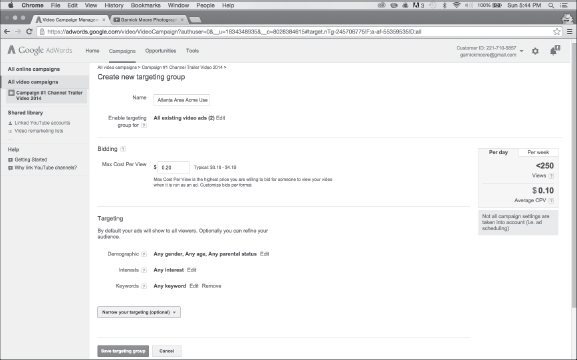
- In the Demographic section, click the Edit link and select the demographic groups you want to reach.
You can select any combination of age, gender and parental status by checking or unchecking the respective categories. When you're happy with your selection, click the Done button.
- In the Interests section, click the Edit link and choose the interest profiles that you want to reach.
Interest groups come in three flavors:
- Affinity audiences are groups of viewers who are particularly enthusiastic about certain topics, such as fashion, comics, or home décor. If you're marketing to enthusiasts, this is your best bet.
- In-market audiences are viewers who are currently shopping for a particular type of product. For example, you can reach viewers who are evaluating a new computer in the Computer & Peripherals category.
- Other audiences groups viewers who are have demonstrated a general interest in certain topics. For example, people who occasionally visit websites about cars can be reached in the Autos & Vehicles category.
Explore these categories using the + sign buttons in front of every category. You can drill down over several levels to find very specific interest groups that match your marketing goals, as shown in Figure 13-11. Click the Add link next to a group to add it to your targeting set. When you're done with your selection, click the Done button.
- If you want to refine your targeting even further, click the Narrow Your Targeting drop-down box and among between Topics, Remarketing, Keywords, and Placements.
We explain the purpose of these targeting types earlier in this chapter in the “Configure more narrow targeting” section. Each of these targeting types works in the same way: Click the Edit link to make modifications, then explore the list of options to find the ones that match your goals, then click the Add link to include them in your targeting. When you're happy with your selection, click the Done button.
- Click the Save Targeting Group button.
This will create your new targeting group. You will see it in the list of targeting groups on the Targets tab.
With the campaign and targets set up, you must now associate one or more ads with the campaign. You can find out how to do that in later sections, but first we take care of one last side issue — your remarketing list.
Figure 13-11: Choosing specific Topics to target for YouTube TrueView ads.
Sharing your remarketing list
Remarketing is all about targeting viewers who have already interacted with your channel, videos, or website, by either viewing your content, seeing your ads, visiting your channel, or subscribing to your channel. You can set up remarketing when you build an individual campaign, or you can set it up separately so that your remarketing lists can be shared among different campaigns. If you want to share remarketing lists, follow these steps:
- Log in to https://adwords.google.com/video.
The home page for Google AdWords for Video appears.
- On the Navigation menu on the left, click Video Remarketing Lists under the Shared Library heading.
This step brings up the Video Remarketing page.
- Click the red + Remarketing List button.
You see the Create Remarketing List dialog box.
- Select the remarketing items you want to use from the dialog box's List Type drop-down menu.
The List Type drop-down menu (see Figure 13-12) shows all actions a viewer could have made in order to make them eligible for retargeting options. Select the most relevant actions for this particular remarketing list.
- Click the Create List button.
Figure 13-12: Remarketing lists for YouTube TrueView ads.
 You can also remarket to viewers who have watched content similar to yours — just select that option in the Details section of the Video Remarketing page. (Note that YouTube decides what content is “similar” — you have to take its choice or leave it.)
You can also remarket to viewers who have watched content similar to yours — just select that option in the Details section of the Video Remarketing page. (Note that YouTube decides what content is “similar” — you have to take its choice or leave it.)
You can find more in-depth details about remarketing with YouTube by making your way to https://support.google.com/adwords.
Placing and Managing Your Ads
Lots of people set up their video and display ads when they configure their general campaign settings. Just remember that you can also add ads to an existing campaign. No matter where you are in your ad campaign, here's how to get that scintillating ad of yours in front of your viewers:
- Log in to https://adwords.google.com/video.
The home page for Google AdWords for Video appears.
- Click the name of the campaign you want to work with.
It should be listed under the All Video Campaigns section of the Navigation menu on the left side of the page.
- Click the red + Video Ad button in the Campaign Details section of the AdWords page.
Doing so opens a Create New Ad page.
- Paste the YouTube video URL of your ad into the Your Video field.
The video has to be uploaded to your YouTube channel before you do this. Videos that are to be used as ads need to be either public or unlisted. Check Chapter 9 for details on how to upload a video.
As soon as you paste a correct video URL, you will see your video with its thumbnail picture, and several additional options will appear.
 Your YouTube ad might be the first thing that people see about your company, so use a video that is short, catchy, and to the point.
Your YouTube ad might be the first thing that people see about your company, so use a video that is short, catchy, and to the point. - Select the ad format you want to use.
Select or deselect the check boxes in from of the In-stream and In-display formats, depending on which one you want to use for this ad. It's best to use only one format per ad because it gives you the best control over your bidding and targeting strategy. If you want to use the same video in different formats, create separate video ads for each.
- If you've chosen an in-stream ad, use the In-stream section of the new page that appears to configure your in-stream ad.
Figure 13-13 shows you the in-stream configuration options of the ad creation page. (Note that you have an input panel and preview pane that shows what your ad will look like for both types of TrueView ads — in-stream and in-display.)
Here's a rundown of the in-stream settings:
- Display URL: This is the website link that is shown on your video ad.
 This isn't the destination that the user goes to when the ad is clicked, so keep this one short, sweet, and informative. Viewers need some sense of where they'll end up, so be sure to get that information across.
This isn't the destination that the user goes to when the ad is clicked, so keep this one short, sweet, and informative. Viewers need some sense of where they'll end up, so be sure to get that information across. - Destination URL: This is the actual web location where viewers end up after they click.
 Do not indulge in bait-and-switch tactics. Always send viewers to a web page that clearly has something to do with the ad. If you try to trick your viewers, you'll only end up wasting your ad budget and alienating viewers who may be interested in your channel, product, or services.
Do not indulge in bait-and-switch tactics. Always send viewers to a web page that clearly has something to do with the ad. If you try to trick your viewers, you'll only end up wasting your ad budget and alienating viewers who may be interested in your channel, product, or services. - Companion banner: This is a 300 × 60 pixel companion banner for YouTube display or a 300 × 250 pixel companion banner for the GDN. The companion banner should have a strong call to action so that viewers are more likely to click. Note that the companion banner is the only element that remains up after your video ad has finished playing or has been skipped by the user. We recommend the YouTube default banner if you have a several videos on your channel or if you are looking to gain subscribers with your ad. It gives the viewer three options: Subscribe, watch more content, or visit your destination URL.
- Display URL: This is the website link that is shown on your video ad.
- If you've chosen an in-display ad, take the following steps to configure your in-display ad:
- Write the ad text. This short bit of text appears next to the video thumbnail in your ads. (See Figure 13-14.) You get one headline with a maximum length of 25 characters and two lines of description text with 35 characters apiece.
 Attach a catchy title, and be sure to tell people why they should watch this video. You can test ad copy by creating multiple versions of the in-display ad.
Attach a catchy title, and be sure to tell people why they should watch this video. You can test ad copy by creating multiple versions of the in-display ad. - Choose the thumbnail picture that you want to use. YouTube gives you only four predefined options. See the “Thumbnails” section in Chapter 9 for tips on how to select an effective one.
- Enter your website address in the Display URL field. This is the web address that appears in the ad for viewers to see.
- If you want to direct viewers to a particular page other than your website's home page, enter a web address in the Destination URL field. For example, you could use a landing page that promotes a specific product. When users click on your video ad, they're sent to this page.
- Write the ad text. This short bit of text appears next to the video thumbnail in your ads. (See Figure 13-14.) You get one headline with a maximum length of 25 characters and two lines of description text with 35 characters apiece.
- Enter the ad name.
Use a descriptive name that makes it easy for you to find the ad later.
- Select the targeting groups for the ad.
By default, all existing targeting groups are selected.
 You can set up multiple targeting groups for your ads to optimize the results. For example, you can set up one target group only for search keywords, another one for topics, and a third one for specific channel placements. To add a targeting group, go to https://adwords.google.com/video, select the campaign you want to change, and click the Target tab. Then click the New Targeting Group button and follow the steps in the “Selecting bidding and your target audience” section, earlier in this chapter.
You can set up multiple targeting groups for your ads to optimize the results. For example, you can set up one target group only for search keywords, another one for topics, and a third one for specific channel placements. To add a targeting group, go to https://adwords.google.com/video, select the campaign you want to change, and click the Target tab. Then click the New Targeting Group button and follow the steps in the “Selecting bidding and your target audience” section, earlier in this chapter. - Click Save.
- If this is the first time you've bought ads on Google or YouTube, you're asked for your billing information.
Follow the simple process on the screen to provide your credit card information.
 You're billed for your AdWords account only after you start your ad campaign.
You're billed for your AdWords account only after you start your ad campaign. - Verify the status of your ad.
If your money's good, you should see your new ad listed in the Details section of the AdWords for Video home page. Looking at the Status category, you should see the text Not yet serving/Under review. That's a good sign. It's proof that your ad is complete — you just need to wait on final approval from Google. Usually, that takes no more than 24 hours. If it's taking any longer, call AdWords Google support at 866-246-6453 to see whether there's a problem.
Be sure to check out how your ads are performing after your ads are approved by Google. (You can find out more on how you can actually do that in the next section.) Monitor your campaigns regularly to find the most effective videos, targeting groups, and ads. Always test different versions of your ads, and make changes, if necessary.
 If you need to modify an ad name or ad copy after the ad has been saved, you lose all the performance data associated with that ad. Click the little arrow next to the title of the ad in the Details section to make any edits. (If you want to keep your performance data, we recommend duplicating the ad and then making changes to the new version of the ad.)
If you need to modify an ad name or ad copy after the ad has been saved, you lose all the performance data associated with that ad. Click the little arrow next to the title of the ad in the Details section to make any edits. (If you want to keep your performance data, we recommend duplicating the ad and then making changes to the new version of the ad.)
 You can always pause an ad campaign from the All Video Campaigns view by highlighting the check box next to the campaign name and clicking the Change Status drop-down menu so that it shows Paused. We recommend that you never remove an ad because you can't get it back in case you change your mind.
You can always pause an ad campaign from the All Video Campaigns view by highlighting the check box next to the campaign name and clicking the Change Status drop-down menu so that it shows Paused. We recommend that you never remove an ad because you can't get it back in case you change your mind.
Measuring Clicks and Results
Tracking the success of your campaign regularly is essential. If you don't pay attention, you may be spending ad dollars for ineffective views, or you might miss out on interesting opportunities to reach your audience. Fortunately, the YouTube ad management tool gives you all the important numbers you need in order to manage your campaign.
When you analyze your campaign results, it's important to understand the following distinction:
- Paid metrics: These represent the direct results of your ads, such as ad views and the average cost per view.
- Earned metrics: Think of these as the follow-on activities that occur as a result of your ads, including new subscribers and additional channel views.
Both sets of metrics are important to advertisers and YouTube channel managers because they tell them whether their ad money is being spent effectively.
 You're charged for paid metrics, not for earned metrics. If your video ad results in a viewer going to your channel and watching ten more videos, you paid for 1 view and received 10 for free. In other words, that's 11 views for the price of 1.
You're charged for paid metrics, not for earned metrics. If your video ad results in a viewer going to your channel and watching ten more videos, you paid for 1 view and received 10 for free. In other words, that's 11 views for the price of 1.
Looking at campaign information
The YouTube ad management tool is your friend. To gain the full benefit of this friendship, you need to visit (you guessed it) https://adwords.google.com/video and click the All Video Campaigns link to see the most important performance numbers. You also see the details for every video campaign.
These are your paid metrics. This list describes what the numbers mean:
- Impressions: These figures represent how many times your ad was shown to a user (irrespective of whether the user clicked on it). Thumb impressions refer to the little picture-and-text in-display ads in search results and next to videos, whereas Video impressions count how many times your video was shown as an in-stream ad just before another video.
- Views: This number shows how many views your videos got by way of paid ads. For in-display ads, a view is counted when a viewer clicks on an ad and starts watching the video. For in-stream ads, a view means the user watched at least 30 seconds of the ad (or the whole ad if it's shorter).
- View rate: This represents the percentage of people who saw your ad and either clicked on it (for in-display) or chose not to skip it (for in-stream). Don't be disappointed if this number seems low. Typical rates are well under 1 percent for in-display and around 15-20 percent for in-stream ads. The higher the number, the more effective your ad.
- Average cost per view (CPV): This figure tells you how much you spent for one person to watch your video. This value can differ depending on the topic and the amount of competition you face, but ranges between 4 cents and 40 cents are typical.
- Total cost: This is the total amount you spent on all your YouTube ads.
Successful campaigns have a high view rate and a low CPV. But what the numbers should be depends strongly on your industry. Some industries, such as financial services, are highly competitive in their online marketing efforts, so expect a high CPV amount. In other industries, you may be able to draw viewers for only a few cents a pop.
 Watch how your campaign performs over time. When the view rate value drops and your CPV rises, it's time to optimize.
Watch how your campaign performs over time. When the view rate value drops and your CPV rises, it's time to optimize.
Getting earned metrics
The great part about YouTube advertising is that it can lead to increased viewer activity with your channel. These are earned metrics, and they include:
- Earned views: The number of new video views that occur within seven days from viewers who've seen an ad from your channel
- Earned subscribers: The number of new subscriptions that occur within seven days from unsubscribed viewers who've seen an ad from your channel
- Earned playlist additions: The number of playlist additions that occur within seven days from viewers who've seen an ad from your channel
- Earned likes: The number of video likes that occur within seven days from viewers who've seen an ad from your channel
- Earned shares: The number of video shares that occur within seven days from viewers who've seen an ad from your channel
Earned metrics are not displayed by default, so you have to set them up through AdWords for Video:
- Log in to your AdWords for Video account.
The home page for Google AdWords for Video appears.
- Click All Video Campaigns in the Navigation menu on the left.
- Click the Campaigns tab.
- Click the Columns button and select Customize Columns from the menu that appears.
You're presented with a Customized Columns configurator, like the one shown in Figure 13-15.
Figure 13-15: Adding earned metrics data to AdWords for video reporting.
- Click Earned Actions.
- Select each of the earned metrics you want to add by clicking the Add link next to each earned metric.
- Click the Save button.
You now have full access to your earned campaign metrics.
 This technique can be used for customizing all reporting, including adding and removing other paid metrics as well as competitive metrics around impressions.
This technique can be used for customizing all reporting, including adding and removing other paid metrics as well as competitive metrics around impressions.
Optimizing Your Campaign
Because you pay for every click on your YouTube ads, you must choose highly effective keywords and placements for your campaign. When you initially create your campaign, you make certain assumptions about which targets will deliver results. Some assumptions may turn out to be wrong, and you may want to try other options over time.
Fortunately, YouTube offers a powerful way to manage targets for every video ad. Follow this step-by-step approach:
- Log in to your AdWords for Video account.
The home page for Google AdWords for Video appears.
- Click All Video Campaigns in the Navigation menu on the left.
- Click on the campaign you want to optimize, and then click the Segment by Targeting Group link.
- Look at the campaign details.
You see the number of views you've received and the amount of money you've spent for each ad. Below these numbers, you see a list of the targeting groups that have contributed to these results.
- Review the list of targeting groups to determine which ones are effective.
The most important number is the cost per view, or CPV — the amount you pay for every viewer who sees your video because of that particular keyword. Low CPVs are attractive, but sometimes you may want to spend more on targeted keywords.
- To optimize a targeting group, click the Targets tag and then click the name of the targeting group you want to change.
- Click on each category link under the Targeting heading to look at the details of how your keywords and placements perform.
You can look at detailed information for YouTube search keywords, display network keywords, topics, and placements.
- Remove the nonperforming keywords and placements by clicking the green button next to them and selecting Paused from the menu that appears.
 Pause keywords and placements, rather than delete them, because the performance information for paused targets is retained by the system.
Pause keywords and placements, rather than delete them, because the performance information for paused targets is retained by the system. - If you have ideas for additional keywords, click the Add Keywords button or Add Placements button to add them.
 If you aren't drawing enough views, consider increasing your bid on the targets that you particularly like. Click the Targets tab and then the Edit link next to the name of the targeting group you want to change. Increase the value of maximum CPV and click the Save and Enable Targeting button.
If you aren't drawing enough views, consider increasing your bid on the targets that you particularly like. Click the Targets tab and then the Edit link next to the name of the targeting group you want to change. Increase the value of maximum CPV and click the Save and Enable Targeting button.
Creating a Call-to-Action Overlay
After you draw viewers to your video, you want them to then take action — by coming to your website, for example, or by signing up for your newsletter or even buying your product online.
YouTube advertisers use an attractive feature that lets you place a call-to-action message on top of your videos. This call-to-action overlay consists of a small picture, three lines of text, and a link to your website, and it starts up immediately when your video plays.
It's an effective way to draw YouTube viewers to visit your site.
Follow these steps to create a call-to-action overlay:
- Log in to your YouTube account.
- On your YouTube page, click your channel's icon and then choose Creator Studio from the menu that appears.
Doing so brings up the Creator Studio dashboard.
- Click the Video Manger heading in the Navigation menu on the left.
- Click Video under the Video Manager heading.
Doing so brings up the Video page.
- Find the video you're using for advertising and click the Edit button.
If your video is public, you see a call-to-action overlay link under the video on the same level as Basic Info and Advanced Settings.
- Click the Call-to-Action Overlay link.
You're prompted for overlay information, as shown in Figure 13-16.
- Add a headline and two lines of description text for your overlay.
This should be a strong call to action that entices people to click on it.
 Special offers always work well.
Special offers always work well. - Enter the display URL and the destination URL that you want to use.
The display URL is the web address that people see in the overlay (www.acmeelectric.com, for example). The destination URL is the link to the page that opens when someone clicks on the overlay. It can be a product-specific page, as in this example:
www.acmeelectric.com/products/z500.
- (Optional) Click the Choose a File to Upload button to upload a picture file from your computer.
The image has to be in a format of 74 × 74 pixels.
- Click the Save Changes button.
The overlay should become active almost immediately. Play your video to verify it.
In 2014, YouTube announced the premium advertising platform Google Preferred, an in-stream advertising format that allows advertising to target the top 1 percent and the top 5 percent of the most popular content on YouTube. The figure below shows popular Google Preferred channels for technology. The lineup changes regularly.
Google Preferred is targeted at big-brand spenders and has a premium price that Google will discuss with you privately. As an advertiser, don't despair if you can't buy the top 1 percent or 5 percent of YouTube. The other 95 percent of content on YouTube may actually be better suited for your channel objectives — and your budget.
